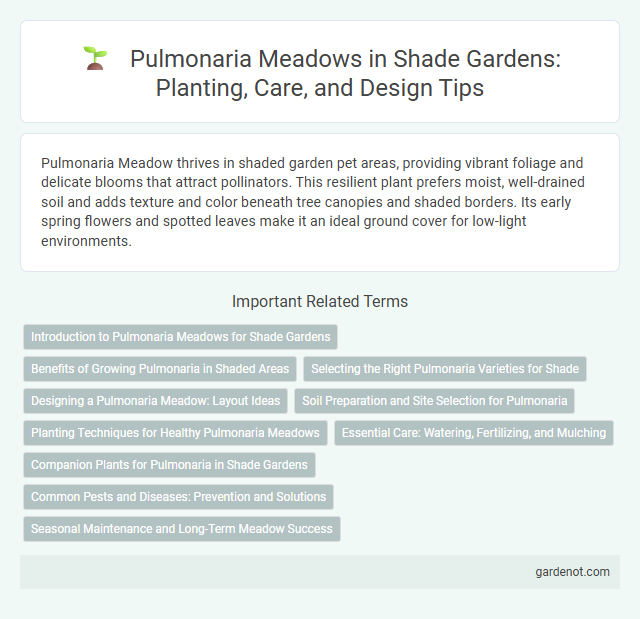Pulmonaria Meadow thrives in shaded garden pet areas, providing vibrant foliage and delicate blooms that attract pollinators. This resilient plant prefers moist, well-drained soil and adds texture and color beneath tree canopies and shaded borders. Its early spring flowers and spotted leaves make it an ideal ground cover for low-light environments.
Introduction to Pulmonaria Meadows for Shade Gardens
Pulmonaria meadows thrive in shaded garden areas, offering vibrant, early spring blooms with blue, pink, and white flowers that attract pollinators such as bees and butterflies. This shade-loving perennial features spotted, textured foliage that provides year-round interest and helps suppress weeds within dense plantings. Pulmonaria meadows are low-maintenance, drought-tolerant once established, and ideal for underplanting beneath trees or alongside woodland paths.
Benefits of Growing Pulmonaria in Shaded Areas
Pulmonaria meadow thrives in shaded garden areas by enhancing soil moisture retention and providing early spring blooms that attract pollinators. Its dense foliage suppresses weeds while enriching the garden ecosystem with natural ground cover. The plant's tolerance to low light conditions makes it an ideal choice for under-tree or shaded borders, promoting biodiversity and aesthetic appeal year-round.
Selecting the Right Pulmonaria Varieties for Shade
Pulmonaria varieties such as 'Raspberry Splash,' 'Blue Ensign,' and 'Opal' thrive in shade gardens by offering vibrant foliage and early spring blooms. Selecting Pulmonaria with varying leaf patterns and flower colors can create visual interest throughout the growing season under low light conditions. Prioritize species with strong disease resistance and moisture tolerance to ensure healthy growth in shaded, humid environments.
Designing a Pulmonaria Meadow: Layout Ideas
Designing a Pulmonaria meadow involves grouping Pulmonaria species with varied leaf patterns and flower colors to create visual interest throughout the seasons. Arrange plants in clusters of different heights, pairing them with complementary shade-loving perennials like ferns and hostas to enhance texture and depth. Incorporate naturalistic curves and mulch pathways to maintain moisture and emphasize the meadow's soft, woodland aesthetic.
Soil Preparation and Site Selection for Pulmonaria
Pulmonaria thrives in well-drained, humus-rich soil with a slightly acidic to neutral pH range of 6.0 to 7.0, making soil preparation crucial for its growth in shade gardens. Choose a location with partial to full shade, avoiding direct sunlight that can scorch the leaves, and amend the soil with organic matter like compost to improve moisture retention and nutrient availability. Proper site selection and soil enhancement ensure vibrant foliage and healthy blooms for Pulmonaria in shaded environments.
Planting Techniques for Healthy Pulmonaria Meadows
Pulmonaria meadows thrive in well-drained, consistently moist soil with partial to full shade, mimicking their natural woodland habitat. Plant root divisions or seedlings in early spring or fall, spacing them 12-18 inches apart to allow air circulation and prevent fungal diseases. Incorporate organic mulch and maintain moisture levels to support vigorous growth and vibrant foliage throughout the growing season.
Essential Care: Watering, Fertilizing, and Mulching
Pulmonaria Meadow thrives in consistently moist, well-drained soil, requiring regular watering especially during dry periods to maintain its vibrant foliage. Fertilize in early spring with a balanced, slow-release fertilizer rich in nitrogen and potassium to support healthy growth and flowering. Applying a layer of organic mulch helps retain soil moisture, suppress weeds, and regulate temperature, creating an optimal environment for Pulmonaria in shade gardens.
Companion Plants for Pulmonaria in Shade Gardens
Pulmonaria thrives in shade gardens alongside companion plants such as hostas, ferns, and astilbes that share similar moisture and light requirements, creating a lush understory. These companion plants enhance Pulmonaria's early spring blooms by providing contrasting foliage textures and sustained garden interest throughout the growing season. Grouping Pulmonaria with shade-tolerant species like Heuchera and Epimedium supports biodiversity and improves soil health by maintaining consistent moisture and organic matter.
Common Pests and Diseases: Prevention and Solutions
Pulmonaria meadow, commonly known as lungwort, is prone to powdery mildew and slugs, which can cause significant damage in a shade garden setting. To prevent these issues, ensure good air circulation by spacing plants appropriately and apply organic slug repellents or traps. Regular inspection and removal of affected leaves help manage powdery mildew, while resistant cultivars reduce susceptibility to pests and diseases.
Seasonal Maintenance and Long-Term Meadow Success
Pulmonaria meadows require regular removal of spent flowers and dead leaves during spring to promote healthy growth and prevent disease. Applying organic mulch in early autumn conserves moisture and suppresses weeds, supporting the plants through winter dormancy. Consistent soil monitoring and periodic nutrient amendments enhance long-term bloom density and resilience in shaded garden environments.
Pulmonaria meadow Infographic

 gardenot.com
gardenot.com